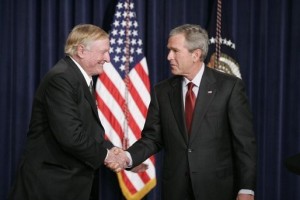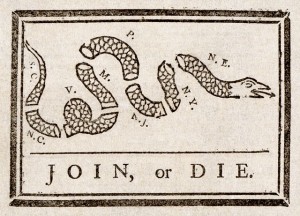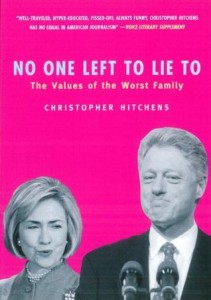Correction: As the commenter below points out, Jason Richwine is a regular contributor to National Review Online. We regret the error.
One of the benefits of the Trump campaign, regardless of one’s thoughts on the merits of a Trump presidency, is its exposure of the conservative establishment. The irony of an undisciplined and at times extremely uncouth candidate, whose grasp of policy is tenuous, to say the least, obliterating the intellectual veneer of a movement with hundreds of millions of dollars in endowments and countless scholars at its disposal is one which will be endlessly analyzed in the years to come. Professor George Hawley’s book, Right-Wing Critics Of American Conservatism, does not seek to analyze or deconstruct the Trump phenomenon, but it does hold some clues as to why Donald Trump has succeeded in dismantling a political infrastructure which has dominated the Republican Party for over half a century.
This book is a marvelous discovery for a number of reasons, not least because it provides a coherent, internally consistent definition of conservatism, as well as its ideological antipode, contemporary liberalism. After examining and rejecting several philosophical distinctions between the right and the left-including Thomas Sowell’s assertion that this divide reflects a difference in beliefs about the innate malleability of human nature-Hawley arrives at an intelligible cleavage between these two very broad political groupings. He asserts that the left/modern liberalism is an ideology which extols equality as the primary virtue above all others when considering how our society should be structured, whereas the right/conservatives view equality as a subsidiary or ancillary value within our society.
Although the goals of the left have shifted over the course of time, with campaigns to redistribute wealth and level economic inequalities being replaced by affinity groups emphasizing racial, sexual, and spiritual identities-to the consternation of some traditional leftists-it has retained its emphasis on radical egalitarianism. Just as the right, with a few exceptions, has always placed some other value above regimented equality. Professor Hawley is not the first scholar to make the observation that the modern conservative movement is largely a synthetic, artificial creation. The fact that it is a union of three widely disparate strands of right wing thought, i.e. foreign policy hawks, libertarians, and religious/traditionalist conservatives, is common knowledge.
However, he has broken new ground by exploring just how this tenuous marriage has made mainstream conservatism an ideology of such narrow public appeal, in a book which gives a respectful hearing to its most important right wing critics. In addition to examining the grievances voiced by paleoconservatives, Objectivists, anarcho-capitalists, among others who were drummed out of-or never invited in to-respectable conservatism, he also points up the hypocrisy of conservative icons such as William F. Buckley Jr., as well as his less impressive heirs, and asks some pointed questions. For example, why did a vociferous defender of Senator Joe McCarthy believe that the anti-Communism of the John Birch Society was beyond the pale? Also, why are the seemingly benign sociological observations of Jason Richwine worse than the anti-civil rights editorials from the early days of National Review?
While these stances could be chalked up to a natural Burkean evolution, a much more reasonable explanation is that the leaders of the conservative movement, or racket, as some would describe it, simply want to insulate themselves from any legitimate challenge from the right. While opponents of conservatives have always adhered to a policy of no enemies on the left, movement conservatism has taken precisely the opposite tack, making alliances of convenience with its ostensible enemies whenever popular right wing movements threaten its place within the political firmament. By imposing rigid constraints upon the range of ideas which can be expressed, the conservative movement has simultaneously marginalized grassroots conservatism while emboldening and strengthening its theoretical enemies. Which explains why writers who enthusiastically support the dismemberment of unborn children up to the moment of birth remain well-respected members of the socially progressive commentariat, while conservative scholars who publish academically rigorous papers demonstrating the burden unskilled immigrants impose upon American taxpayers are ritualistically denounced and shunned by the likes of Rich Lowry and his peers.
These periodic purges of right wingers have real-world consequences, which Professor Hawley methodically illustrates in a book which those promoting a chimerical Ben Sasse candidacy, or the deus ex machina scenario envisioned by Bill Kristol, would benefit from reading. He demonstrates how unappealing mainstream conservatism has become to the majority of the American electorate, despite the fact that conservatives still exert an outsized influence over American politics. There are a number of reasons for this, including the enormous and unrelenting demographic change imposed through mass immigration-a policy we’ve explored at length on this website-the increasing secularization of the American public, the lingering stigma of Bush administration failures both domestically and abroad, and finally, the almost complete cession of popular culture to the left. The investment that the conservative movement has made in politics over the past half-century has been complete, despite Andrew Breitbart’s trenchant observation that politics is downstream from culture.
It’s entirely possible that all of these developments collectively, or one of them in isolation, would have ultimately limited the appeal of mainstream conservatism to the American public. However, the epistemic closure within the conservative movement-and demonization of any intellectual on the right, whether it be Ayn Rand or Pat Buchanan, who defies its dogma-has created a situation where no one outside of the hermetically sealed world of Bucklyean conservatism is willing to seriously entertain its increasingly irrelevant arguments. The ossified nature of contemporary American conservatism, which, supply side economics aside, has changed remarkably little since the ascendancy of Goldwater Republicanism and the new right, is one of the main takeaways from this book.
Even as the cultural left has notched victory after victory-forcing mainstream conservatism to adopt almost all of its central premises-the boundaries of acceptable discourse within the the respectable right have become more and more narrow. Thus, we have essays which could have been penned by Joan Walsh appearing in a magazine which describes itself as the most influential magazine and website for conservative news and opinion. The fact that there now exists an unbridgeable divide between conservative elites and their purported audience has been acknowledged by no less a conservative mandarin than Peggy Noonan of the Wall Street Journal.
Whatever merit fusionism once held during the Cold War, its time has clearly passed. The splintering of the right-and consequent loss of power by its putative leaders-has opened up a long-suppressed discussion of what conservatism in its organic form means. Professor Hawley’s work is an invaluable starting point for that conversation.








One problem here: Rich Lowry published Jason Richwine on NRO, has done so long after he was forced out of Heritage. He also opposed low-skill immigration, cites scholars opposed to it all the time.
I stand corrected. He was a contributor to NRO even after being fired by the Heritage Foundation. I am glad that the leftist embargo upon his work didn’t completely succeed. I’m less convinced that Lowry opposes mass immigration-in any broad, philosophical sense-particularly considering how he’s reshaped the magazine after the departure of John O’Sullivan. Not simply how he dealt with Mark Steyn and John Derbyshire, 2 of the last NR writers whose work was actually worth reading, but who he’s entrusted with power and the editorial priorities he’s pursued.